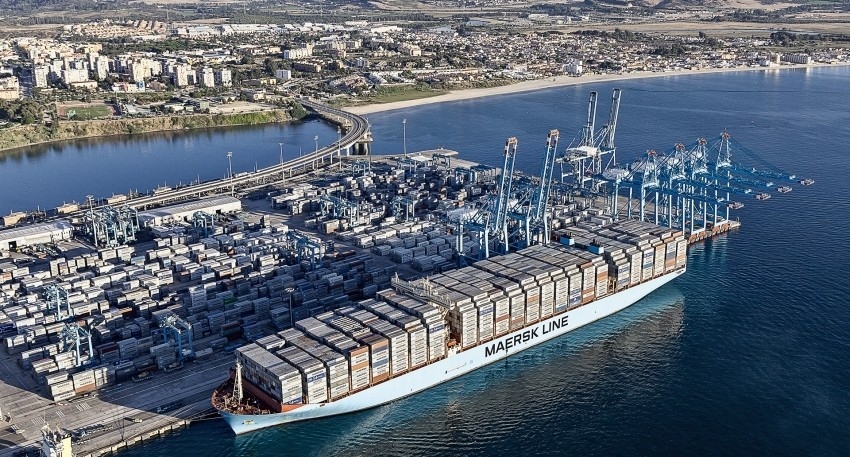AP Moller – Maersk sees double digit increase in Q2 Transport and Logistics revenue
Shipping - Recovering from the June cyber attack, of AP Moller – Maersk has reported strong numbers in Q2, 2017.

August 17, 2017: Recovering from the June cyber attack, AP Moller – Maersk has reported strong numbers in Q2, 2017.
In Q2, the revenue of AP Moller - Maersk grew by 8.4 percent to $9.6bn year on year, mainly due to higher freight rates in Maersk Line. The underlying profit in Q2 improved from $134m to $389m with Maersk Line contributing with an underlying profit of $327m. As a result of post-tax impairments of $732m related to Maersk Tankers and APM Terminals, the reported result was a loss of $264m.
Transport and Logistics reported consolidated revenue of $7.7bn, which was an increase of 15 percent compared to same quarter last year, and an underlying profit of $442m which was improved significantly, in large part driven by higher container freight rates. Energy delivered an underlying profit of $182m in Q2, with Maersk Oil as the main contributor.
The performance of A.P. Moller - Maersk in Q2 was mainly driven by a profitable Maersk Line due to continued recovery in the container market and focus on restoration of profitability. Full-year guidance is reiterated for 2017, despite an expected negative financial impact of $200–300m in Q3 from the recent cyber-attack.
“Maersk Line is again profitable delivering in line with guidance, with revenue growing by $1bn year-on-year in the second quarter. The profit was $490m higher than the same quarter last year, based on higher rates. Focus on the oil and gas related businesses in Energy remains on optimising performance and exploring new business models to strengthen resilience under the current market conditions,” said Soren Skou, CEO, AP Moller - Maersk.
At the end of June, AP Moller - Maersk was hit by the malware “Not Petya” where system shutdowns resulted in significant business impact, especially within the container business. Soren Skou continued,
“In the last week of the quarter, we were hit by a cyber-attack, which mainly impacted Maersk Line, APM Terminals and Damco. Business volumes were negatively affected for a couple of weeks in July, and as a consequence, our Q3 results will be impacted. We expect the cyber-attack will impact results negatively by $200-300m.”
Transport and Logistics are progressing towards operating as one integrated division and delivering the expected synergies estimated to create a ROIC improvement of two percentage points by the end of 2019. Maersk Line's volume growth of approximately 7–8 percent (equity weighted) at APM Terminals and the stronger results reported by Maersk Container Industry are examples of those synergies.
The announced acquisition of Hamburg Süd is progressing as planned. The transaction remains subject to regulatory approval, with an expected closing in Q4 2017. The announced agreement to divest Mercosul Line will facilitate the authority approval process in Brazil.
Maersk Line reported a profit of $339m (loss of $151m) with a positive ROIC of 6.7 percent (negative 3.0 percent). The underlying result was a profit of $327m (loss of $139m). Market fundamentals continued to improve in Q2 as demand growth of 4 percent outgrew nominal supply growth of 1.4 percent. The improvement in market fundamentals in past quarters has started to reflect in the freight rate, which increased 22 percent compared to Q2 2016 and 7.6 percent compared to Q1 2017. Freight rates were increased by 36 percent on East-West trades and 17 percent on North-South trades. Transported volumes grew by 1.7 percent compared to Q2 2016. Volume grew on head-haul by 5.2 percent; however, offset by a decrease on backhaul by 5.6 percent as backhaul cargo was less attractive on some trades.
APM Terminals reported a loss of $100m (profit of $112m). The result was impacted by impairments of $250m ($ 8m) in a few commercially challenged terminals, partially offset by divestment gain of $34m. The underlying profit of $98m ($109m) was negatively impacted by exchange rates and lower rates.
Damco reported a break-even result (profit of $10m) with a ROIC of 1.0 percent (18.5 percent). The underlying result was at break-even (profit of $10m), negatively impacted by increased product investments and lower ocean margins, positively offset mainly by supply chain management margins, air freight volumes growth and productivity improvements.
Svitzer reported a profit of $ 19m ($ 24m) and a ROIC of 5.8 percent (7.8percent), impacted by $ 12m impairment on 11 idle vessels marketed for sale due to fleet optimisation and by $ 6m impairment on investment in Ardent, the 50 percent owned salvage company. The underlying profit amounted to $33m ($23m), due to a $10m increase in deferred tax asset.
Maersk Container Industry reported a profit of $15m (loss of $21m) and a positive ROIC of 18.0 percent (negative 19.6 percent). The underlying profit was $15m (loss of $21m), positively impacted by higher volumes, increased efficiencies and higher market prices for dry containers.
AP Moller - Maersk's expectation of an underlying profit above 2016 ($711m) is unchanged despite the expected negative impact from the June cyber-attack. Gross capital expenditure for 2017 is still expected to be $5.5-6.5bn ($5.0bn). The guidance for 2017 excludes the acquisition of Hamburg Süd.


